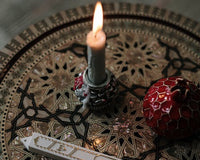Tzitzit can be found at the corners of the tallit and are an important part of the Jewish faith. The tallit is a prayer garment typically worn by men and boys at synagogue services, although it is sometimes worn by females as well. All adult males, as well as many male children, are clothed in white, fringed prayer shawls with black or blue stripes on them – the tallit. The tzitzit are attached to the tallit's corners and can hardly go unnoticed.
Here we will examine what tzitzit represent and why they matter so much.
What Are Tzitzit?
The Hebrew word tzitzit means "fringes" and refers to the threads that are tied to the four corners of a tallit. A tallit is a Jewish prayer shawl that is worn over the shoulders during prayer service, Shabbat, and on other important occasions.

The tzitzit addition to the garment worn by Jewish people is in obedience to God's commandment in the Torah. Wearing tzitzit fulfills two Torah laws, including Number 37, a section known as Parshat Shlah. The midrash also links this lesson to the Torah's dramatic way of introducing the commandment, as follows:
"That shall be your fringe; look at it and recall all the commandments of the LORD and observe them, so that you do not follow your heart and eyes in your lustful urge. Thus you shall be reminded to observe all My commandments and to be holy to your God." (Numbers 15:39–40)
People wear them to commemorate God and his laws. According to rabbis, the tzitzit are very significant.
Tzitzit are required to be worn throughout the day per Jewish law. They are intended to be pinned on four-cornered garments. However, most clothing do not have corners these days. As a result of this, the tzitzit should be worn on the prayer shawl or the special small tallit, called the tallit katan. The tallit katan is a form of the tallit that some Jews wear all day and conceal beneath their clothing. The tzitzit may be tucked inside or worn on the garment's sash.
The Tzitzit Tassels
The threads attached to the fringes of the tallit, whether it's a mini-tallit or tallit gadol, are called tzitzit. They have almost always been made out of white wool and another color and must be spun with a sacred intention in order for them to serve their function. This is why, if a thread snaps, you must use special tzitzit threads as a replacement for it.
Four threads are threaded through a hole and looped over on each corner, resulting in eight hanging strings. The first few inches of each corner's tassel are joined into a single cord with a sequence of double knots and coils. The remaining six threads are then left to hang down.
The History of Tzitzit

Hundreds of years ago, Jews wore the blue and white tzitzit on all of their clothing. However today, they are usually confined to ritual dress. Tzitzit are not just strings attached loosely to the corners of clothes, but rather unique threads produced especially to perform a commandment of God, otherwise called a mitzvah. How does this work?
The first thing to note is that there is no Torah obligation for a person to buy a four-cornered garment to obey the mitzvah of tzitzit. A person only becomes obligated to attach tzitzit to a four-cornered garment if he wears one.
However, wearing a tallit katan (a small four-cornered garment with tzitzit attached) will remind you of your commitment to observe all mitzvah throughout the day. Because maintaining a positive attitude toward the mitzvah is crucial, you must be constantly reminded of it and its significance. The keyword is "remind" since the laws of God should be always in our hearts. Having a symbol that evokes a reminiscence of the law of God close will help us obey.
When wearing the tallit (prayer shawl), it is good to hold the tzitzit while reciting the blessing over them. This is in keeping with God's command. Summarily, the tzitzit lead to recollection or remembrance. This, in turn, leads to the observance of the law of God. The significance of tzitzit was established by God for the Jewish people and they have been incorporated into Jewish religious traditions ever since.
Tzitzit are more than just decorative religious symbols. The intricate design of all the strings reminds us that God’s presence is always there for those who seek Him, even when we can't see it! In addition, wearing tzitzit reminds us about our obligations to all the mitzvot.
What the Number of Knots and Strands on Tzitzit Represent
The eight strings and five knots that form the tzitzit on each side of a prayer shawl represent 613 Commandments. Each letter in ancient Hebrew has an associated number (gematria). The sum of the numerical values of the five Hebrew letters that make up tzitzit add up to 600.
When all these components are added together – including the eight fine threads and five knots – you get a total of 613 (the number of the commandments in the Torah). The tzitzit, as previously stated, is intended to evoke memories of God's law so that we may fulfill them.
How the Tzitzit was Worn on the Jewish Prayer Shawl and Tallit Katan Compared to How It Is Worn Today

The commandment to wear tzitzit appears in the V'ahavta section of the Shema prayer. Traditional Jewish law requires people to wear tzitzit on every four-cornered garment they put on, and this is exactly how Jews wore the tzitzit in earlier times. However, most clothing does not have corners these days, which is why they are usually only seen on traditional prayer shawls.
The tzitzit, today, can be found on large tallits called tallit gadol or on small tallits called tallit katan, which some traditional Jews wear under their clothing. Some people allow the tzitzit from their tallit katan to hang out, while others wrap them up in their belts.
Tzitzit wearing has a lot to do with personal choice in recent times. Even though many authorities in rabbinic literature today urge men to wear their tzitzit hanging out as a more visible reminder, there are Rabbinical texts that permit tzitzit to be tucked in.
The idea is that while reciting the lines from Numbers regarding tzitzit, we will untuck our tzitzit and that looking at the fringes will be enough of a deterrent against sinful thoughts. This is why some men today wear their tzitzit outside their garments for easy access, but tuck them away or wrap them around their belts, making them less conspicuous.
Tzitzit are a symbol of religious pride for many, but some men think they look messy and tuck their corners to avoid appearing undignified. Others may not necessarily like the way that excess cloth swings when they move around or walk down main streets, but they still pay attention to the commandment on noticeable fringes!
There are a variety of ways to assess whether or not to expose one's tzitzit, depending on both personal taste and the community's interpretation of the Torah commandments.
How to Pray with Tzitzit

A tallit is worn at morning services on weekdays and Shabbat, as well as on the night of Yom Kippur and other holy days. At weekday morning prayers, tefillin are also worn. Tallits should be put on before tefillin, and you should have both on before beginning the prayers.
Tzitzit, as a mitzvah, can be done by completely draping oneself in the fringed garment, which is only achievable through wearing the tallit. When donning the tallit, special prayers are said thus:
"Blessed are you, Lord our G‑d, King of the universe, who has sanctified us with His commandments, and commanded us to enwrap ourselves with tzitzit."
When you have finished reciting the blessings above, you are to wrap the tallit around your shoulders like a cloak and briefly clench your hands in front of your face to cover your head. Then you can adjust it comfortably on your shoulders so it drapes nicely around your neck without being too tight or constricting free movement
Keep in mind that during the Baruch She'amar and the Shema parts of the morning prayers, it is conventional to hold the fringes of the tallit in your hands. You may also follow the instructions in your prayer book on when to gather the corners of your shawl in your hands and when to kiss and release them. This is the perfect way to fulfill the mitzvat of tzitzit while you pray!
How to Tie and Wear Tzitzit

You can tie your tzitzit in five simple steps without making any mistakes, and it is possible to do so even if you are doing this for the first time. However, before going further, we recommend practicing on a variety of clothes to prepare yourself.
The tzitzit bundle contains sixteen tzitzit strands (four long ones and twelve short ones). Separate the pieces to create four groups of three short strings and one long one. The Shamash, which is a long strand, is used in the windings.
- With three short and one long string, hold them together in a corner of your tallit. Push through to make sure they are even with the other two ends before pulling all four strings back through so it will be even with the first three short strings. The Shamash will be longer than the other strings on the prayer shawl. Attach four strands to one side of the material and four on the other, forming a double knot.
- Next, using one hand to hold the seven shorter strings and the Shamash in the other, wind the Shamash around in a spiral seven times. It makes no difference whether you wind clockwise or counterclockwise; nevertheless, count the wraps meticulously. Make sure that the wraps begin and end on the same side. This matters a lot to the eventual outcome.
- Tie another double knot on the Shamash, then return it to its original group and make a duplicate tie. Wrap 8 times around the Shamash and a double knot on one side. Wrap and tie to the left using a final double knot as you finish each pair of knots. Make sure to double-check the number of wraps for each pair of knots. Repeat for the remaining three corners.
- The Sephardic tying technique adds a unique twist to the pattern. Bring around your Shamash each time it is brought out, take under previous wind before winding more turns onto its string and create this curving ridge that runs along tzitzit strings for an interesting look!
- Finally, when all four corners are bound, you may gather them together and cut the ends if they are too long.
What Holy Land Market Has to Offer You

You're undoubtedly more interested in tzitzit now that you've learned about their religious and spiritual significance. All tallit katan and tallit gadol include the tzitzit. From the basic to the most ornate wool and cotton tallits, tzitzit can be found on their corners.
Tzitzit are one of the most important materials of Jewish worship, and you must have them properly prepared for their religious purpose. Having your tzitzit on tassels at Shabbat will give you more pride than being without them.
If you are a parent who wants guidance while buying their son's first set or a young man who wants more information about procuring your own, Holy Land Market is here to help. We offer good quality tzitzit at the best possible price. Holy Land Market is one of the most popular tzitzit providers across the world, and there are several reasons why you should consider ordering from us.
Made in Israel
Immerse yourself in the ancient Judaism of Israel with this prayer shawl with tzitzit! Our tallits are handcrafted in Israel by Jewish devotees, making them a perfect way to reconnect your mind and body while deeply focusing on worshiping God.
Wool and Linen Tallit Katan
Our wide selection of tallit sets will make sure that your son, grandson, or other loved one has the perfect outfit for their big day. We provide traditional woolen tallits and different tzitzit options. Contact us right away if you need help finding a set – we’re happy to assist everyone looking forward to celebrating Judaism!
Intentional prayer is a great way to strengthen your spiritual connection. Our tallits and tzitzits are made with quality material that will last you for years of wear. They're perfect for people who want their prayers to be done with a deep connection and those who wish to honor God through daily wearing.
Explore Holy Land Market and find your next favorite Jewish worship resource. We have a wide variety of goods, wears, gift items, and everything you need for beautiful prayer at home or in your community!






